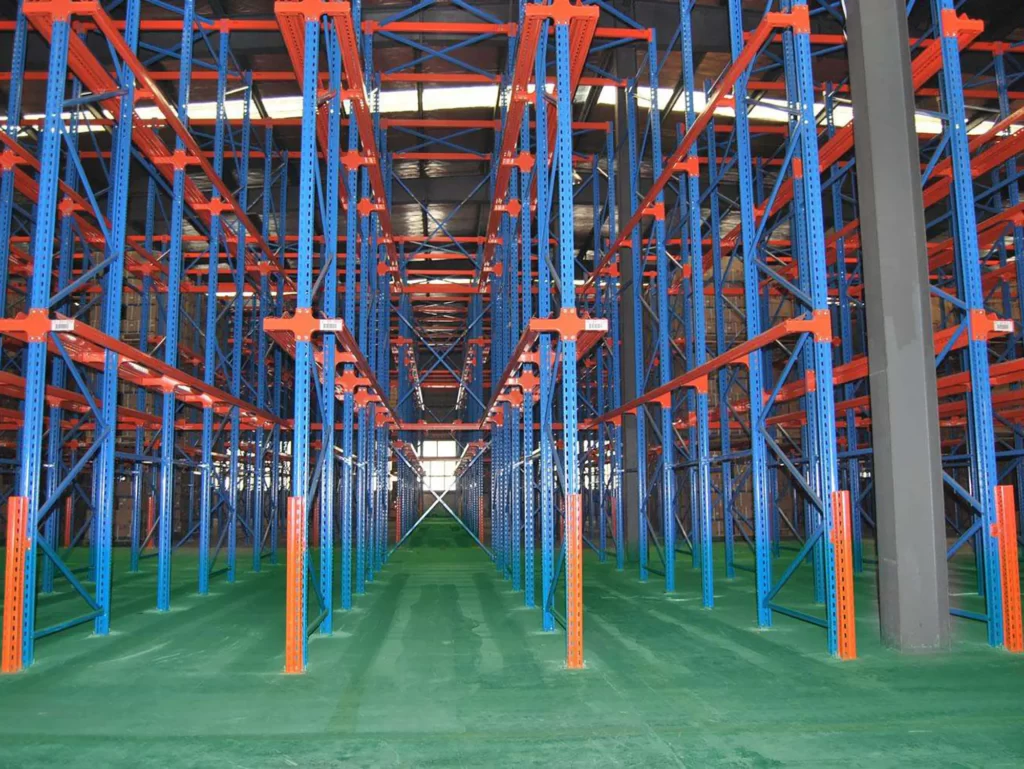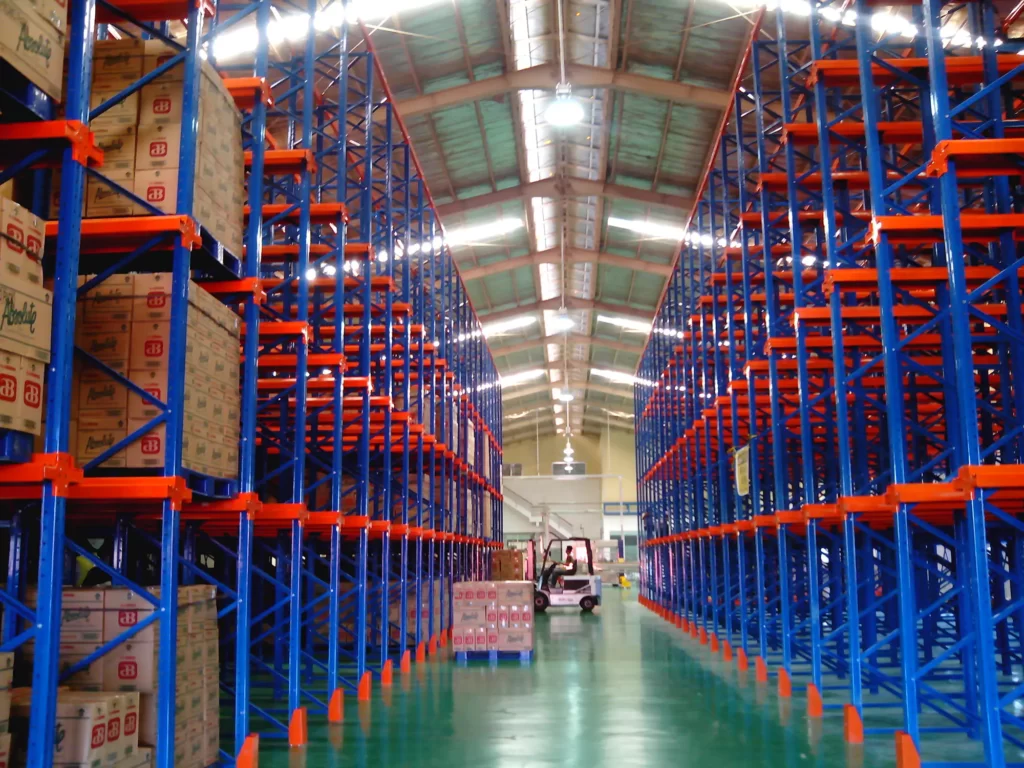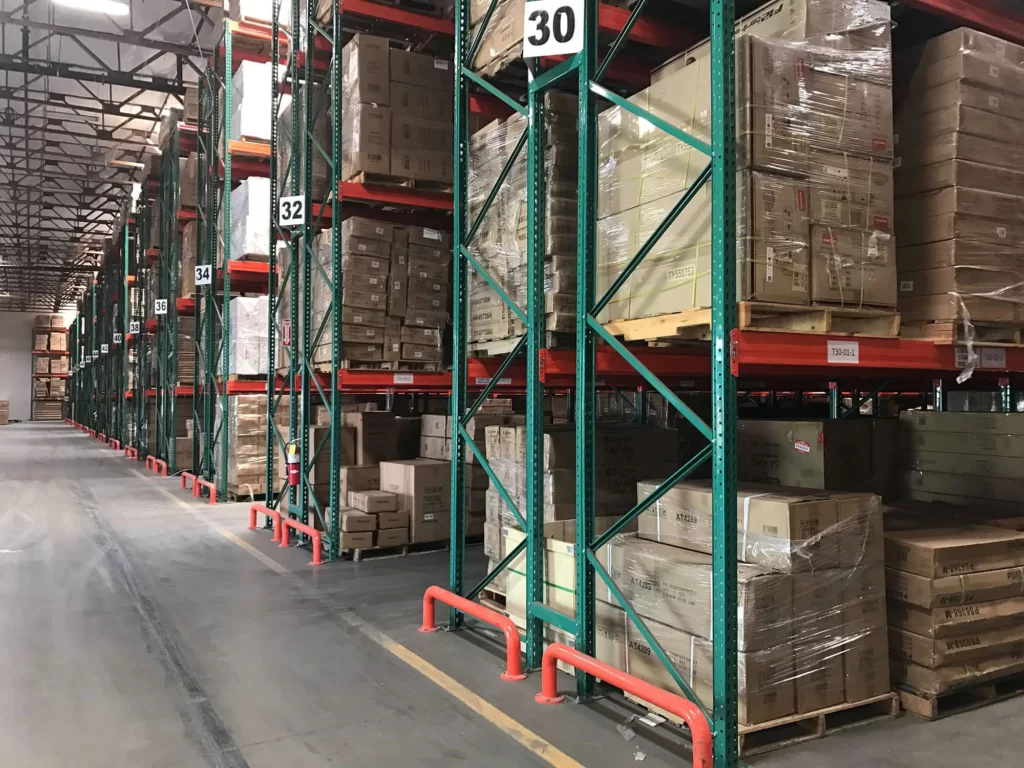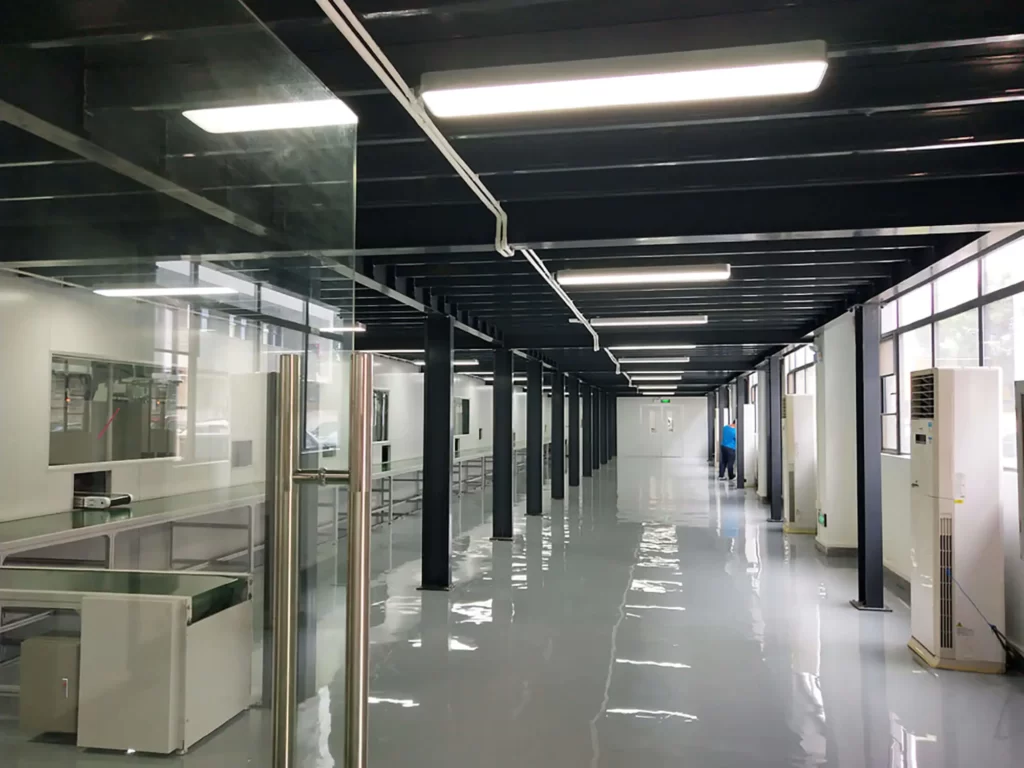At first sight, drive-in racking vs drive-through racking seems to have no difference, as both terms might refer to the same storage solution. However, that is a huge mistake! Although they are both labeled as compact racking systems and share a similar overall structure, these tipos de rack vary in numerous important areas.
So, if you are wondering what their differences and commonalities are, as well as which rack type is the better choice for your warehouse, congratulations, as you have knocked on the right door.
After perusing this informative post, you will have answers to all the questions above. Such insights will surely assist you in selecting the ideal racking system that satisfies your inventory requirements.
Major Benefits Of Compact Racking Systems
As mentioned earlier, drive-in racks and drive-through racks are both classified as compact storage solutions. This umbrella term refers to inventory systems that manage to condense the storage area more than standard solutions.
Besides drive-in and drive-thru types, compact storage solutions also include other racking systems, such as racks push-back, mobile pallet racks, and live pallet racks. All of these solutions have the following major benefits:
- Improved space optimization: With their novel structures, compact storage systems can optimize warehouse space by reducing unused sections, thereby enabling high-density storage and increasing storage capacity.
- More organized facility: By designating specific places for various sorts of goods, compact solutions improve warehouse organization and allow for quick goods handling. An organized facility not only lowers the likelihood of misplacing items but also minimizes time spent looking for them.
- Acessibilidade aprimorada: Compact storage systems minimize aisles between racks or shelves by condensing storage into a small space, thus allowing for immediate access to objects. This benefit is particularly beneficial in facilities that need regular access to specific products.
- Augmented security: Certain compact storage solutions are equipped with lockable doors that help prevent unwanted entry into your storage area. This feature provides augmented security for your items by keeping them safe and sound, especially if you’re storing confidential papers or important assets.
Sistema de racks drive-in
Before delving into the detailed matchup of estanteria drive-in vs drive-through racking, it’s essential to get to know each of these storage systems first. This section will walk you through all the basics of the drive-in system.
This storage solution consists of one or a few multi-tiered racking aisles, each of which is typically three to five pallets deep, designated for a distinctive SKU, and only accessible from the front. In other words, this storage solution has entry loading points only, resulting in a simple and straightforward structure.
Intended for LIFO inventory management, the drive-in storage system helps make storage space more efficient and enable forklifts to drop and collect pallets directly into the structure. As each lane is accessible from the front only, forklifts need just one work aisle to handle pallets.
This feature removes all wasted space and thus maximizes storage density, allowing for more pallets to be kept in the same footprint. You may even install two drive-in systems back-to-back to further maximize warehouse space. In that case, make sure to build separating bars between the two systems to avoid forklift mishaps.

Vantagens
The drive-in inventory system is favored by most warehouses, thanks to the following advantages:
- Estrutura simples: This storage solution shares the same simple design as conventional systems, with uprights and horizontal beams to generate various lanes. They are accessible from one side only, allowing forklifts to drive inside the racking structure to load or unload pallets.
- Optimizing space utilization: The next primary benefit of drive-in systems is their ability to achieve optimal utilization of both floor areas and vertical space. Warehouses may store items densely, allowing them to fully use their storage capacity. This is especially useful for firms dealing with large amounts of goods.
- Minimizing product damage: Today’s drive-in systems are built to last. Thanks to their durable uprights and stable pallet locations, they can significantly reduce the danger of items being damaged during loading and unloading activities. Plus, this improved structural integrity guarantees that the system lasts longer.
- Boosting order completion efficiency: Thanks to the space-efficient structure, drive-in solutions facilitate a more simplified operation. This implies that items can be moved around effortlessly, minimizing the time required to complete orders. This leads to speedier delivery times and higher customer satisfaction.
Desvantagens
Every coin has two sides, and the drive-in solution is no exception. Besides the benefits above, this storage system also comes with a few disadvantages:
- Low selectivity: As initial pallets are kept deep inside the storage aisles, taking out the front pallets is required to reach those in the rear. This disadvantage may lead to longer retrieval times and decreased accessibility when compared to other storage systems, such as selective racks.
- Riscos de colisão: Drive-in systems are easily damaged due to their design and closeness to an operating forklift. To avoid collision risks, forklifts must have appropriate side-to-side clearance and be narrow enough to avoid driving over the base plates or bumping into the rack’s uprights.
Aplicações
Warehouses that have minimal product turnover, often non-perishable items, or those without an early expiration date will find drive-in solutions to be the ideal choice. In other words, items whose value is unaffected by inventory time will be suitable for this storage solution.
Homogeneous and non-perishable commodities, such as bricks, cement, and metal products, are ideal candidates for drive-in systems.
Drive-Through Racking System
Now that you know what drive-in solutions are, it’s high time to explore their sibling called the drive-through system. Despite their relatively similar names, the drive-through type has many different aspects.
While drive-in solutions are appropriate for the LIFO technique because they employ a single aisle for both loading and unloading, drive-through systems are best suited to the FIFO approach since they use two distinct lanes for those functions.
Also, the drive-through system demands additional storage space. As a result, it’s impossible to place this solution against the warehouse wall, which is a smart strategy when employing drive-in systems. Instead, drive-through racking systems are often positioned in an open area, allowing forklifts to drive through the entire structure.

Vantagens
Like drive-in solutions, drive-through racking systems are also a smart choice for many warehouses due to the benefits below:
- Better suited for the FIFO approach: Drive-through systems accept pallets from one end and return them to the other end, thereby making them ideal for the FIFO inventory management. This approach also facilitates better product control.
- Enhanced accessibility to stored items: This advantage is fairly straightforward. As warehouse operators can drive forklifts and access stored items from both racks’ ends, it definitely enhances accessibility to all merchandise inside the structure compared to drive-in systems.
- Lowering collision risks: As the name suggests, forklifts can drive through this racking system in a single direction (from one end to the other end). Also, drive-through systems have wider aisles to allow forklifts to move in and out of the racks safely.
- Speeding up goods handling processes: In addition to reducing collision risks, the single-direction travel of forklifts brings about faster goods handling activities. Drive-through systems can achieve that by allowing forklifts to drive in and out of the racks in the same direction.
Desvantagens
Apart from the pros mentioned above, drive-through solutions also possess certain drawbacks that require your careful consideration.
- Relatively lower inventory density: Unlike drive-in solutions, drive-through systems have wider aisles and lower rack depths to accommodate the forklift movements. The combination of these factors results in lower inventory density.
- Needing more space for installation: Due to the two entry points, drive-through solutions require wider aisles for forklifts to maneuver. Therefore, in order to install this storage system in your warehouse, you will need to prepare more space.
Aplicações
Drive-through storage solutions are perfect for warehouses with a high product turnover since they work well with the FIFO principle. This amazing storage solution also offers flawless stock rotation, which is ideal for holding goods with a finite shelf life or whose value decreases with time.
Because of this, drive-through systems are often reserved for storing perishable goods like food, beverages, or chemicals. They are also applicable in warehouses with limited space, as well as in cold storage facilities.
Drive-In Racking Vs Drive-Through Racking: Full Comparison
Here comes the main reason why you chose to read this article. The following part will walk you through a comprehensive comparison between drive-in racking vs drive-through racking, from their similarities to their differences.
Comunalidades
To set the stage for comparing the two compact storage systems, it’s important to note that they share a similar foundation construction and are both high-density inventory solutions. Both drive-in and drive-through racks aim to make the most efficient use of your warehouse’s floor area and ceiling height.
The second commonality is that both racking systems are well-suited to forklifts, allowing these material handling equipment to go straight into their structure to pick up and retrieve pallets.
Plus, both drive-in and drive-thru racking systems allow for effective inventory management in the warehouse, as each lane in these solutions is devoted only to a single product type.
Diferenças
Besides those commonalities above, both of these racking systems vary in numerous aspects. Keep on reading to explore their differences via the seven criteria below:
#1: Entry Points
The first primary distinction between drive-in and drive-thru racks lies in the number of entry points that each system has. Drive-in solutions have only one entry point, which is at their front. Forklifts drive inside the structure to handle the products, then head outside by moving backwards on the same path.
Regarding the drive-through racking system, it has two entry points: one at the front and the other at the rear of the structure. With this layout, forklifts can enter the racking system at one end and exit via the other end.
#2: Inventory Management Method
The difference in the number of entry points above results in this second divergence. With the drive-in system, the most recently loaded pallet must be the first to leave before you can access the inner pallets. Therefore, this storage system is suitable for the LIFO inventory management method.
On the other hand, drive-through solutions are applicable to the FIFO approach only. This is possible because the first pallet put on the rack is the first to be unloaded.
#3: Product Rotation
Compared with drive-in storage systems, drive-through solutions offer better product rotation.
In the drive-through system, allowing goods to be loaded at one rack’s end and unloaded from the other, helps prevent the accumulation of older stock, thereby promoting more efficient product rotation. In contrast, drive-in solutions with their LIFO approach can potentially lead to prolonged storage of older inventory.
#4: Selectivity
When weighed against drive-in systems, drive-through racking solutions provide superior selectivity.
Drive-through racks make inventory management simpler since forklifts can reach both the front and rear pallets inside the storage lanes. Thus, they are useful if you need to access various items. On the contrary, to get pallets further down the drive-in structure, the only way is to take out the front pallets, which may lengthen the retrieval process.
#5: Required Installation Space
Drive-in storage systems require less surface space for installation than their drive-through siblings.
This distinction stems from the structural differences of both storage solutions. Since loading and unloading activities happen at the same entry point, drive-in systems can be installed against the warehouse wall, resulting in less space being required.
However, this feature is not possible with drive-through solutions, which must be placed in open areas.
#6: Applicable Products
Drive-in, as well as drive-through solutions are both designed to serve distinct sets of commodities.
Warehouse professionals often utilize drive-in storage solutions to hold items with low turnover, non-perishable, or whose value is unaffected by inventory duration. On the other hand, drive-through racks are ideal for products with high turnover, perishable, or those with a limited shelf life.
#7: Upfront Costs
Drive-in inventory solutions generally require lower upfront costs compared to drive-through solutions.
This is primarily due to the simpler design and construction of drive-in racks. As they are designed to accommodate multiple pallets stored in depth, they need fewer vertical supports and fewer overall structural components.
Yet, drive-through solutions often require more space for installation, which can lead to higher real estate or construction expenses.
Drive-In Racking Vs Drive-Through Racking: Summary Table
It’s nearly impossible to mesmerize all the commonalities and differences between drive-in racking vs drive-through racking after just one read. Therefore, feel free to go over the post again, or utilize the following summary table to brush up your memory.
| Drive-In Solutions | Drive-Through Solutions | ||
|---|---|---|---|
| Semelhanças | Armazenamento de alta densidade | ||
| Well-suited for forklifts | |||
| Offering effective warehouse inventory management | |||
| Diferenças | Pontos de entrada | completa | Dois |
| Gestão de Inventário | LIFO | FIFO | |
| Rotação de produtos | Não tão bom | Melhor | |
| Seletividade | Não tão bom | Melhor | |
| Espaço de instalação necessário | Menos espaço necessário | Mais espaço necessário | |
| Produtos aplicáveis | Having low turnover, non-perishable | Having high turnover, perishable | |
| Custos antecipados | Abaixe | Mais alto | |
Conclusão
To sum up, warehouses may benefit from both drive-in and drive-through systems, but each solution is designed to solve distinct inventory management requirements.
In short, while drive-in systems are more suited for high-density storage of homogeneous items, drive-through racks offer superior selectivity for time-sensitive inventory.
Understanding their similarities and distinctions will allow you to make more educated judgments about warehouse storage and efficiency. For most cases, it usually boils down to FIFO vs LIFO product management to decide between drive-in and drive-through systems. Thanks for reading!








